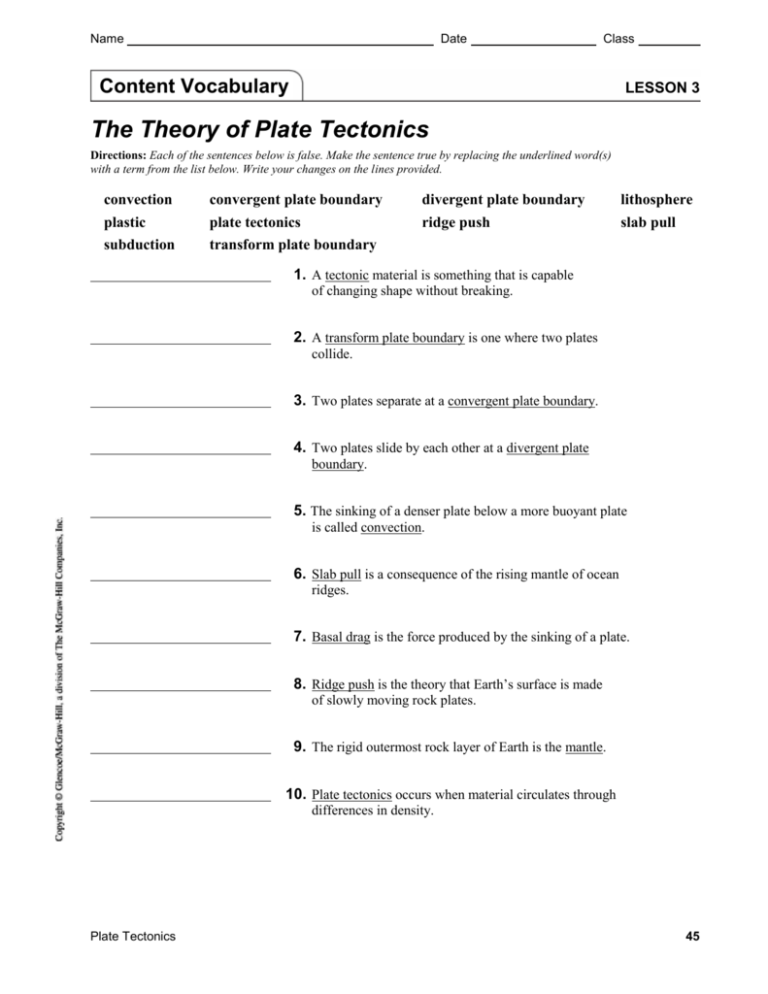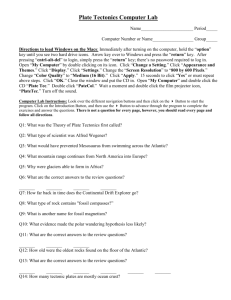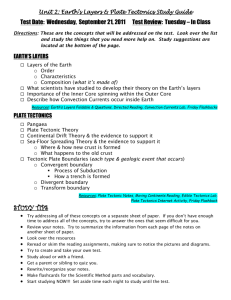Lesson-3-WSs-for-upload1
advertisement

Name Date Class Content Vocabulary LESSON 3 The Theory of Plate Tectonics Directions: Each of the sentences below is false. Make the sentence true by replacing the underlined word(s) with a term from the list below. Write your changes on the lines provided. convection plastic subduction convergent plate boundary plate tectonics transform plate boundary divergent plate boundary ridge push lithosphere slab pull 1. A tectonic material is something that is capable of changing shape without breaking. 2. A transform plate boundary is one where two plates collide. 3. Two plates separate at a convergent plate boundary. 4. Two plates slide by each other at a divergent plate boundary. 5. The sinking of a denser plate below a more buoyant plate is called convection. 6. Slab pull is a consequence of the rising mantle of ocean ridges. 7. Basal drag is the force produced by the sinking of a plate. 8. Ridge push is the theory that Earth’s surface is made of slowly moving rock plates. 9. The rigid outermost rock layer of Earth is the mantle. 10. Plate tectonics occurs when material circulates through differences in density. Plate Tectonics 45 Name Date Class Lesson Outline LESSON 3 The Theory of Plate Tectonics A. The Plate Tectonics Theory states that Earth’s surface is divided into 1. The theory of large plates of rock. Each plate moves over Earth’s and changes position with respect to other plates. a. When plates on the seafloor, mid-ocean ridges form. b. When one plate dives under another plate, earthquakes can result and can form. c. Earthquakes can also result when plates past each other. 2. Of all Earth’s tectonic plates, the plate is the largest. 3. The cold, rigid rock layer on the outermost part of Earth is called the . It consists of crust and the upper part of the . 4. Below the lithosphere is the , which is so hot that it flows like 5. . of lithosphere move because they rest on the flowing asthenosphere. B. Plate Boundaries 1. The place where two plates meet is called a(n) . 2. When two plates move away from each other, a(n) forms. a. In the ocean, are located at divergent plate boundaries. b. If divergent plate boundaries separate parts of a continent, form. 3. When two plates slide by each other, a(n) forms. This type of movement causes . 4. When two plates collide, a(n) forms. a. When plates collide, the plate that is denser slides under the less-dense plate in the process of 46 . Plate Tectonics Name Date Class Lesson Outline continued b. When an oceanic plate slides under a continental plate, a deep ocean forms. Near the trench, a line of forms. c. When two oceanic plates collide, a trench and a(n) form. d. When two continental plates collide, neither plate is subducted, and form. C. Evidence for Plate Tectonics 1. Scientists now use to measure how continents move. 2. The theory of plate tectonics explains why earthquakes and occur in certain locations. D. Plate Motion 1. Earth’s mantle moves because warmer, less-dense materials rise and cooler, denser materials . a. Materials move based on differences in their temperatures and densities in the process of . b. Inside Earth, elements provide some of the thermal energy that causes convection. c. Convection currents form in the mantle when thermal energy transfers from the to the mantle. 2. forces interact to cause tectonic plate motion. a. Convection currents in the mantle produce a force that causes motion called . b. Plates are pushed away from each other at mid-ocean ridges by the force of . c. When a plate sinks below another plate, it pulls on the rest of the plate, exerting a force called . E. A Theory in Progress 1. Plate tectonics is the unifying theory of 2. Plate tectonics theory is still being . as scientists learn more about how Earth’s tectonic plates move. Plate Tectonics 47 Name Date Content Practice A Class LESSON 3 The Theory of Plate Tectonics Directions: Respond to each statement in the space provided. 1. Explain what a divergent plate boundary is. 2. Draw a diagram that shows a divergent plate boundary. 3. Explain what a transform plate boundary is. 4. Draw a diagram that shows a transform plate boundary. 5. Explain what a convergent plate boundary is. 6. Draw a diagram that shows a convergent plate boundary. Plate Tectonics 49 Name Date Math Skills Class LESSON 3 Use Proportions A ratio is a comparison of two numbers. A ratio can be written as a fraction. Two equal ratios can be written as a proportion. For example, 1 = 2 . When two ratios form a 2 4 proportion, the cross products are equal. 1×4=2×2 4=4 If one of the numbers in a proportion is unknown, cross multiply to solve for the unknown number. For example, if 2 = n4 , then 3 2n = 3 × 4 2n = 12 n=6 The Eurasian tectonic plate travels at a rate of about 0.7 cm/yr. How far will the plate travel in 6 years? Step 1 Use the information in the problem to write a proportion. n cm 0.7 cm = 1 yr 6 yr Step 2 Cross multiply to solve for the unknown number. 0.7 × 6 = 1 × n n = 4.2 The Eurasian tectonic plate will travel 4.2 cm in 6 years. Practice 1. The Eurasian tectonic plate travels at a rate of about 0.7 cm per year. How far will the plate travel in 25 years? 2. Along the Mid-Atlantic Ridge, the plates spread at an average rate of 5 cm every 2 years. How far will the plates spread in 12 years? Plate Tectonics 3. If the mountain at a convergent plate boundary is growing at a rate of 1.6 mm per year, how much higher will it be in 50 years? 4. If the mountain at a convergent plate boundary is growing at a rate of 3.6 mm every 2 years, how long will it take for the mountain to rise 27 mm? 53 Name Date School to Home Class LESSON 3 The Theory of Plate Tectonics Directions: Use your textbook to answer each question or respond to each statement. 1. The lithosphere is the cold, rigid outermost rock layer of Earth. Describe where the lithosphere is thick and where it is thin on Earth. 2. The asthenosphere is below the lithosphere. This layer is solid but very hot. How does the asthenosphere allow tectonic plates to move? 3. Plate boundaries occur where two tectonic plates meet. The plates can move in many different ways at the plate boundaries. Define divergent, transform, and convergent plate boundaries. 4. Warmer rock is less dense and rises. Cooler rock is denser and sinks. The circulation of material caused by differences in density is called convection. Describe the three forces that cause plate motion. 54 Plate Tectonics Name Date Key Concept Builder Class LESSON 3 The Theory of Plate Tectonics Key Concept What is the theory of plate tectonics? Directions: Answer each question on the lines provided. 1. What are two examples of tectonic activity? 2. Where does tectonic activity occur? 3. What causes earthquakes? 4. What forms volcanoes? 5. What forms mountains? 6. What type of tectonic activity occurs in the San Andreas Fault? 7. Where are volcanoes located in the mid-ocean ridge? 8. When they are plotted on a map, what do patterns of tectonic activity outline? Plate Tectonics 55 Name Date Class Key Concept Builder LESSON 3 The Theory of Plate Tectonics Key Concept What are the three types of plate boundaries? Directions: Answer each question on the lines provided. 1. What is a plate boundary? 2. Where does a divergent plate boundary form? 3. Where does a convergent plate boundary form? Directions: Put a check mark in the space that correctly identifies the type of boundary. Plate Location Divergent Plate Convergent Boundary Plate Boundary African Plate—South American Plate North American Plate—Juan de Fuca Plate African Plate—Antarctic Plate Eurasian Plate—Philippine Plate North American Plate—Pacific Plate Arabian Plate—African Plate Cocos Plate—Nazca Plate Caribbean Plate—North American Plate Indo-Australian Plate—Pacific Plate 56 Plate Tectonics Name Date Class Key Concept Builder LESSON 3 The Theory of Plate Tectonics Key Concept Why do tectonic plates move? Directions: Identify three forces that act on plates to make them move. 1. 2. 3. Directions: Answer each question to complete the cause-and-effect chart. Cause Effect What happens when buoyant mantle material gets near Earth’s surface? 4. What happens as thermal energy is transferred from the core to the mantle? 5. How can something as massive as the Pacific Plate move? 6. What effect do convection currents inside the asthenosphere have on the lithosphere? 7. Why do plates move away from the mid-ocean ridges? 8. What is the effect on a plate when a slab sinks? 9. What happens when tectonic plates of different densities collide? 10.






